

| Tarsius[1]
Eocene to recent | |
|---|---|
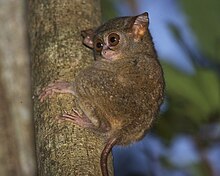
| |
| Gursky's spectral tarsier | |
| Scientific classification | |
| Domain: | Eukaryota |
| Kingdom: | Animalia |
| Phylum: | Chordata |
| Class: | Mammalia |
| Order: | Primates |
| Suborder: | Haplorhini |
| Family: | Tarsiidae |
| Genus: | Tarsius Storr, 1780 |
| Type species | |
| Lemur tarsier Erxleben, 1777 | |
| Species | |

| |
| Distribution and range of Tarsius supriatnai and other tarsier species in Sulawesi, Indonesia: | |
Tarsius is a genus of tarsiers, small primates native to islands of Southeast Asia. Until 2010, all tarsier species were typically assigned to this genus, but a revision of the family Tarsiidae restored the generic status of Cephalopachus and created a new genus Carlito.[1]
All members of Tarsius are found on Sulawesi, while Cephalopachus is found on Sundaland and Carlito in Greater Mindanao.
| Common name | Scientific name and subspecies | Range | Size and ecology | IUCN status and estimated population |
|---|---|---|---|---|
| Dian's tarsier
|
T. dentatus Miller & Hollister, 1921 |
Central Sulawesi, Indonesia
|
Size: 11–12 cm (4–5 in) long, plus 13–28 cm (5–11 in) tail[2][3] Habitat: Forest[4] Diet: Insects, as well as small vertebrates[2] |
VU
|
| Gursky's spectral tarsier | T. spectrumgurskyae Shekelle, Groves, Maryanto & Mittermeier, 2017 |
Northeastern Sulawesi (in purple)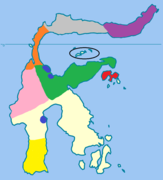
|
Size: About 14 cm (6 in) long, plus 21–27 cm (8–11 in) tail[5] Habitat: Forest[6] Diet: Insects, as well as small vertebrates[6] |
VU
|
| Jatna's tarsier
|
T. supriatnai Shekelle, Groves, Maryanto & Mittermeier, 2017 |
Northern Sulawesi (in gray)
|
Size: About 14 cm (6 in) long, plus 23–25 cm (9–10 in) tail[5] Habitat: Forest[7] Diet: Insects, as well as small vertebrates[7] |
VU
|
| Lariang tarsier
|
T. lariang Groves & Merker, 2006 |
Central Sulawesi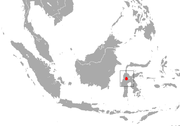
|
Size: About 12 cm (5 in) long, plus 12–21 cm (5–8 in) tail[8] Habitat: Forest[9] Diet: Insects, as well as small vertebrates[9] |
DD
|
| Makassar tarsier | T. fuscus Fischer von Waldheim, 1804 |
Southern Sulawesi (in yellow)
|
Size: 12–13 cm (5 in) long, plus 24–26 cm (9–10 in) tail[10] Habitat: Forest and caves[11] Diet: Insects, as well as small vertebrates[10] |
VU
|
| Niemitz's tarsier
|
T. niemitzi Shekelle, Groves, Maryanto, Mittermeier, Salim & Springer, 2019 |
Northern Sulawesi (circled in black)
|
Size: About 14 cm (6 in) long, plus 24–26 cm (9–10 in) tail[12] Habitat: Forest[13] Diet: Insects, as well as small vertebrates[13] |
EN
|
| Peleng tarsier
|
T. pelengensis Sody, 1949 |
Eastern Sulawesi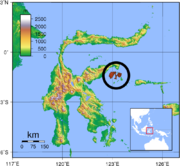
|
Size: 12–14 cm (5–6 in) long, plus 25–27 cm (10–11 in) tail[14] Habitat: Forest[15] Diet: Insects, as well as frogs, lizards, and other small vertebrates[15] |
EN
|
| Pygmy tarsier
|
T. pumilus Miller, Hollister, 1921 |
Central Sulawesi
|
Size: 8–11 cm (3–4 in) long, plus 20–21 cm (8 in) tail[16][17] Habitat: Forest[18] Diet: Arthropods and insects, as well as small vertebrates[16] |
EN
|
| Sangihe tarsier | T. sangirensis Meyer, 1897 |
Sangir Island, southeastern Philippines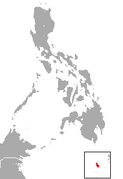
|
Size: 12–13 cm (5 in) long, plus about 30 cm (12 in) tail[19] Habitat: Forest and inland wetlands[20] Diet: Insects, as well as birds, lizards, and other small vertebrates[19] |
EN
|
| Siau Island tarsier | T. tumpara Shekelle, Groves, Merker & Supriatna, 2008 |
Siau Island, north of Sulawesi | Size: 10–15 cm (4–6 in) long, plus about 20 cm (8 in) tail[21] Habitat: Forest[22] Diet: Arthropods, as well as small vertebrates[22] |
CR
|
| Spectral tarsier
|
T. tarsier (Erxleben, 1777) |
Sulawesi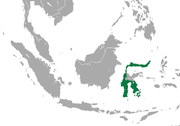
|
Size: 9–14 cm (4–6 in) long, plus 20–26 cm (8–10 in) tail[23] Habitat: Forest[24] Diet: Insects, as well as lizards, bats, and other small vertebrates[23] |
VU
|
| Wallace's tarsier
|
T. wallacei Merker, Driller, Dahruddin, Wirdateti, Sinaga, Perwitasari-Farajallah & Shekelle, 2010 |
Northern Sulawesi (in orange)
|
Size: 11–13 cm (4–5 in) long, plus 23–27 cm (9–11 in) tail[25] Habitat: Forest and inland wetlands[26] Diet: Insects, as well as small vertebrates[25] |
VU
|
As of 2018[update], Fossilworks also recognizes the following additional extinct species:[27]
| Tarsius |
|
|---|---|
| Authority control databases: National |
|
|---|
This primate-related article is a stub. You can help Wikipedia by expanding it. |